Class 7 Maths Ganita Prakash Chapter 1 Large Numbers Around Us NCERT Solutions
Class 7 Maths Ganita Prakash Chapter 1 Large Numbers Around Us NCERT Solutions provide you the best study material available online, covering the exercises and questions of Chapter 1 Large Numbers Around Us.
Class 7 Maths Ganita Prakash Chapter 1 Large Numbers Around Us Questions Answers PDF Download
Page 2
Q. But how much is one lakh? Observe the pattern and fill in the boxes given below.
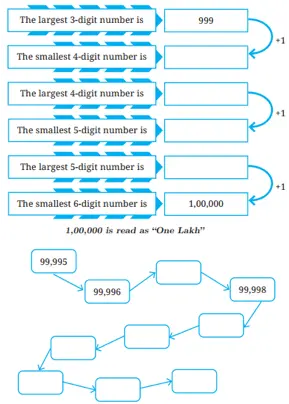
Solution:
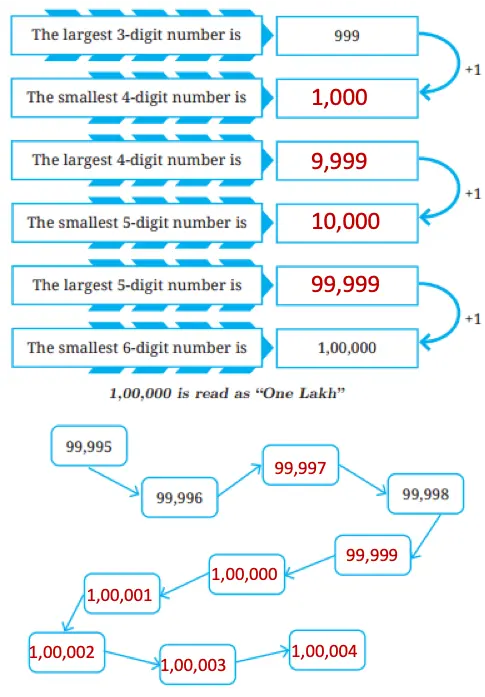
Q. What if we ate 2 varieties of rice every day? Would we then be able to eat 1 lakh varieties of rice in 100 years?
Solution:
Days in a year = 365
Rice varieties eaten per day = 2
Rice varieties eaten in a year = 2 × 365 = 730
Rice varieties eaten in 100 years = 730 × 100 = 73,000 varieties.
Since 73,000 is less than 1 lakh, we won’t be able to eat 1 lakh varieties of rice in 100 years.
Q. What if a person ate 3 varieties of rice every day? Will they be able to taste all the lakh varieties in a 100-year lifetime? Find out.
Solution:
Days in a year = 365
Rice varieties eaten per day = 3
Rice varieties eaten in a year = 3 × 365 = 1095
Rice varieties eaten in 100 years = 1095 × 100 = 1,09,500 varieties.
Since 109,575 is greater than 1 lakh, the person would be able to taste all 1 lakh varieties in a 100-year lifetime.
Page 3
Q. Estu said, “We know how many days there are in a year — 365, if we ignore leap years. If we live for y years, the number of days in our lifetime will be 365 × y.”
Choose a number for y. How close to one lakh is the number of days in y years, for the y of your choice?
Solution:
Assume we live for 95 years, i.e., y = 95.
Number of days in our lifetime = 365 × 95 = 34,675.
Difference between 1,00,000 and 34,675 = 1,00,000 – 34,675 = 65,325.
Figure it out (Page 3)
1. According to the 2011 Census, the population of the town of Chintamani was about 75,000. How much less than one lakh is 75,000?
Solution:
Population of the town in 2011 = 75,000
Since 1,00,000 – 75,000 = 25,000
75,000 is 25,000 less than one lakh.
2. The estimated population of Chintamani in the year 2024 is 1,06,000. How much more than one lakh is 1,06,000?
Solution:
Population of town in 2024 = 1,06,000
Since, 1,06,000 – 1,00,000 = 6,000
1,06,000 is 6,000 more than one lakh.
3. By how much did the population of Chintamani increase from 2011 to 2024?
Solution:
Increase in population from 2011 to 2024 = 1,06,000 – 75,000 = 31,000.
Thus, the population of Chintamani increased by 31,000 from 2011 to 2024.
Getting a Feel of Large Numbers
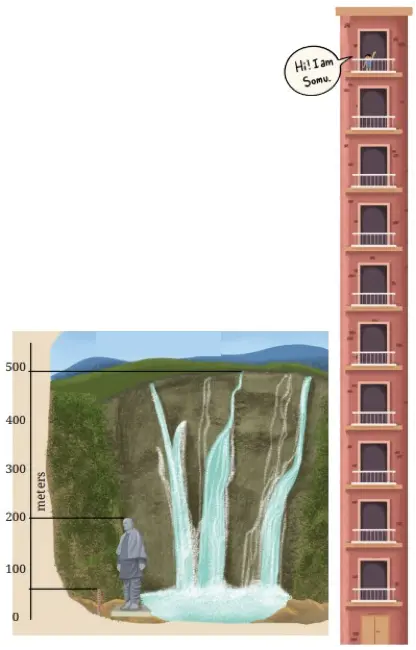
Q. Look at the picture on the right. Somu is 1 metre tall. If each floor is about four times his height, what is the approximate height of the building?
Solution:
Somu’s height = 1 metre
Height of each floor = 4 × 1 = 4 metres
Number of floors in the building = 11
Height of the building = 11 × 4 = 44 metres.
Q. Which is taller — The Statue of Unity or this building? How much taller? ____________m.
Solution:
Height of the Statue of Unity = 180 m
Height of Somu’s building = 44 m
Since 180 – 44 = 136 m
Thus, the Statue of Unity is 140 m taller than the building.
Q. How much taller is the Kunchikal waterfall than Somu’s building? ____________m.
Solution:
Height of the Kunchikal waterfall = 450 m
Height of Somu’s building = 44 m
Since 450 – 40 = 406 m
Thus, the Kunchikal waterfall is 406 m taller than Somu’s building.
Q. How many floors should Somu’s building have to be as high as the waterfall?
Solution:
Height of each floor in the building = 4 m
Height of the waterfall = 450 m
Number of floors required = 450 ÷ 4 = 112.5
So, Somu’s building should have at least 113 floors to be as high as the waterfall.
Page 4
Q. How do you view a lakh — is a lakh big or small?
Solution:
A lakh can seem big or small depending on the context and what it’s being compared to. For instance, a crowd of 1 lakh people at an event or protest is massive, but in terms of city population, 1 lakh might be considered a small town.
Q. Write each of the numbers given below in words:
(a) 3,00,600
(b) 5,04,085
(c) 27,30,000
(d) 70,53,138
Solution:
(a) 3,00,600 – Three lakh six hundred.
(b) 5,04,085 – Five lakh four thousand eighty-five.
(c) 27,30,000 – Twenty-seven lakh thirty thousand.
(d) 70,53,138 – Seventy lakh fifty three thousand one hundred and thirty-eight.
Page 5
Q. Write the corresponding number in the Indian place value system for each of the following:
(a) One lakh twenty three thousand four hundred and fifty six
(b) Four lakh seven thousand seven hundred and four
(c) Fifty lakhs five thousand and fifty
(d) Ten lakhs two hundred and thirty five
Solution:
(a) One lakh twenty three thousand four hundred and fifty six – 1,23,456.
(b) Four lakh seven thousand seven hundred and four – 4,07,704.
(c) Fifty lakhs five thousand and fifty – 50,05,050.
(d) Ten lakhs two hundred and thirty five – 10,02,035.
1.2 Land of Tens
1. The Thoughtful Thousands only has a +1000 button. How many times should it be pressed to show:
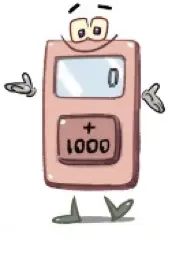
(a) Three thousand? 3 times
(b) 10,000? _________
(c) Fifty three thousand? _________
(d) 90,000? _________
(e) One Lakh? _________
(f) _________ ? 153 times
(g) How many thousands are required to make one lakh?
Solution:
(b) 10,000 ÷ 1,000 = 10 times.
(c) 53,000 ÷ 1,000 = 54 times.
(d) 90,000 ÷ 1,000 = 90 times.
(e) 1,00,000 ÷ 1,000 = 100 times.
(f) 153 × 1000 = 1,53,000.
(g) 1,00,000 ÷ 1000 = 100 thousands.
2. The Tedious Tens only has a +10 button. How many times should it be pressed to show:
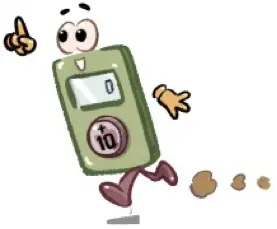
(a) Five hundred? _________
(b) 780? _________
(c) 1000? _________
(d) 3700? _________
(e) 10,000? _________
(f) One lakh? _________
(g) _________ ? 435 times
Solution:
(a) 500 ÷ 10 = 50 times.
(b) 780 ÷ 10 = 78 times.
(c) 1000 ÷ 10 = 100 times.
(d) 3700 ÷ 10 = 370 times.
(e) 10,000 ÷ 10 = 1,000 times.
(f) 1,00,00 ÷ 10 = 10,000 times.
(g) 435 × 10 = 4350.
3. The Handy Hundreds only has a +100 button. How many times should it be pressed to show:
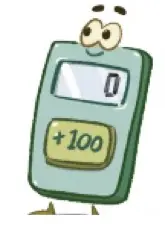
(a) Four hundred? _________ times
(b) 3,700? _________
(c) 10,000? _________
(d) Fifty three thousand? _________
(e) 90,000? _________
(f) 97,600? _________
(g) 1,00,000? _________
(h) _________? 582 times
(i) How many hundreds are required to make ten thousand?
(j) How many hundreds are required to make one lakh?
(k) Handy Hundreds says, “There are some numbers which Tedious Tens and Thoughtful Thousands can’t show but I can.” Is this statement true? Think and explore.
Solution:
(a) 400 ÷ 100 = 4 times.
(b) 3700 ÷ 100 = 37 times.
(c) 10,000 ÷ 100 = 100 times.
(d) 53,000 ÷ 100 = 530 times.
(e) 90,000 ÷ 100 = 900 times.
(f) 97,600 ÷ 100 = 976 times.
(g) 1,00,000 ÷ 100 = 1,000 times.
(h) 582 × 100 = 58,200.
(i) 10,000 ÷ 100 = 100 hundreds.
(j) 1,00,000 ÷ 100 = 1000 hundreds.
(k) Handy Hundreds’ statement is true compared to Thoughtful Thousands because Thoughtful Thousands can’t show multiples of 100 or 10.
However, Handy Hundreds’ statement is false compared to Tedious Tens because Tedious Tens can reach any multiple of 100, although it would take many steps.
Page 6
4. Creative Chitti is a different kind of calculator. It has the following buttons: +1, +10, +100, +1000, +10000, +100000 and +1000000. It always has multiple ways of doing things. “How so?”, you might ask. To get the number 321, it presses +10 thirty two times and +1 once. Will it get 321? Alternatively, it can press +100 two times and +10 twelve times and +1 once.
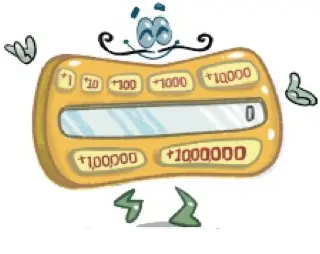
Solution:
First method:
Press +10, 32 times → 32 × 10 = 320
Press +1 once → 1
On Adding, 320 + 1 = 321
Yes, Chitti reaches 321 this way.
Second method:
Press +100, 2 times → 2 × 100 = 200
Press +10, 12times → 12 × 10 = 120
Press +1 once → 1
On adding, 200 + 120 + 1 = 321
Again, Chitti reaches 321.
5. Two of the many different ways to get 5072 are shown below:
These two ways can be expressed as:
(a) (50×100)+(7×10)+(2×1)=5072
(b) (3×1000) + (20×100) + (72 ×1) = 5072
Find a different way to get 5072 and write an expression for the same.
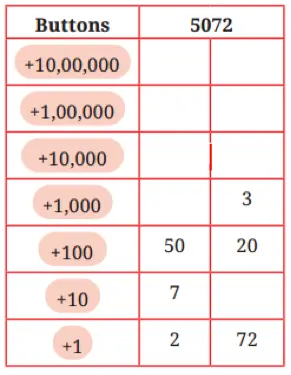
Solution:
(5 × 1000) + (0 × 100) + (7 × 10) + (2 × 1) = 5072.
Figure it out (Page 6)
Q. For each number given below, write expressions for at least two different ways to obtain the number through button clicks. Think like Chitti and be creative.
(a) 8300
(b) 40629
(c) 56354
(d) 66666
(e) 367813
Solution:
(a) 8300
(8 × 1000) + (3× 100) = 8300.
(5 × 1000) + (30 × 100) + (30 × 10) = 8300.
(b) 40629
(40 × 1000) + (6 × 100) + (2 × 10) + (9 × 1) = 40629
(35 × 1000) + (56 × 100) + (2 × 10) + (9 × 1) = 40629
(c) 56354
(5 × 10000) + (6 × 1000) + (3 × 100) + (5 × 10) + (4 × 1) = 56354
(56 × 1000) + (3 × 100) + (5 × 10) + (4 × 1) = 56354
(d) 66666
(6 × 10000) + (6 × 1000) + (6 × 100) + (6 × 10) + (6 × 1) = 66666
(66 × 1000) + (6 × 100) + (6 × 10) + (6 × 1) = 66666
(e) 367813
(3 × 100000) + (6 × 10000) + (7 × 1000) + (8 × 100) + (1 × 10) + (3 × 1) = 367813
(30 × 10000) + (60 × 1000) + (70 × 100) + (81 × 10) + (3 × 1) = 367813
Page 7
Q. Creative Chitti has some questions for you —
(a) You have to make exactly 30 button presses. What is the largest 3-digit number you can make? What is the smallest 3-digit number you can make?
(b) 997 can be made using 25 clicks. Can you make 997 with a different number of clicks?
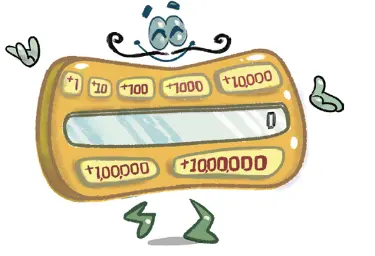
Solution:
(a) The Largest 3-digit number 999, can be obtained as:
(9 × 100) + (9 × 10) + (9 × 1) = 999 (with 27 clicks)
We can reduce one click from the 10’s button (reducing the total by 10) and add 4 clicks to the 1’s button to reach 30 clicks.
This gives:
(9 × 100) + (8 × 10) + (13 × 1) = 993 with exactly 30 clicks.
The smallest 3-digit number 100, can be obtained as:
(9 × 10) + (10 × 1) = 100 (with 19 clicks)
We can reduce one click from the 10’s button (reducing the total by 10) and add 13 clicks to the 1’s button to reach 30 total clicks. This gives:
(8 × 10) + (22 × 1) = 102 with exactly 30 clicks.
(b) (8 × 100) + (19 × 10) + (7 × 1) = 997.
Total clicks = 8 + 19 + 7 = 34.
Therefore, 997 can also be obtained in 34 clicks.
Q. Systematic Sippy is a different kind of calculator. It has the following buttons: +1, +10, +100, +1000, +10000, +100000. It wants to be used as minimally as possible.
How can we get the numbers (a) 5072, (b) 8300 using as few button clicks as possible?
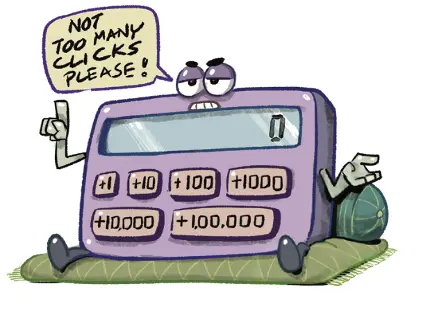
Solution:
(a) 5072
(5 × 1,000) + (7 × 10) + (2 × 1)
Total clicks = 5 + 7 + 2 = 14.
Yes, 5072 can be obtained in 14 button clicks.
(b) 8300
(8 × 1,000) + (3 × 100)
Total clicks = 8 + 3 = 11.
8300 can be obtained in 11 button clicks.
Q. Is there another way to get 5072 using less than 23 button clicks? Write the expression for the same.
Solution:
(5 × 1,000) + (7 × 10) + (2 × 1)
Total clicks = 5 + 7 + 2 = 14.
Yes, 5072 can be obtained in less than 23 clicks i.e., 14 clicks.
Figure it Out
1. For the numbers in the previous exercise, find out how to get each number by making the smallest number of button clicks and write the expression
(a) 8300
(b) 40629
(c) 56354
(d) 66666
(e) 367813
Solution:
(a) 8300
(8 × 1,000) + (3 × 100) = 8300
8300 can be obtained in 8+3 = 11 clicks.
(b) 40629
(4 × 10,000) + (6 × 100) + (2 × 10) + (9 × 1) = 40629
40629 can be obtained in 4+6+2+9 = 21 clicks.
(c) 56354
(5 × 10,000) + (6 × 1,000) + (3 × 100) + (5 × 10) + (4 × 1) = 56354
56354 can be obtained in 5+6+3+5+4 = 23 clicks.
(d) 66666
(6 × 10,000) + (6 × 1,000) + (6 × 100) + (6 × 10) + (6 × 1) = 66666
66666 can be obtained in 6+6+6+6+6 = 30 clicks.
(e) 367813
(3 × 1,00,000) + (6 × 10,000) + (7 × 1,000) + (8 × 100) + (1 × 10) + (3 × 1) = 367813
367813 can be obtained in 3+6+7+8+1+3 = 28 clicks.
2. Do you see any connection between each number and the corresponding smallest number of button clicks?
Solution:
The smallest number of button clicks for each number is the sum of its digits.
3. If you notice, the expressions for the least button clicks also give the Indian place value notation of the numbers. Think about why this is so.
Solution:
The Indian place value system helps in identifying and differentiating between numbers easily by grouping them into thousands, lakhs, crores, etc..
Page 8
Q. How many zeros does a thousand lakh have? _____
Solution:
Thousand lakh = 1,000 × 1,00,000 = 10,00,00,000 and it has 8 zeros.
Page 9
Q. How many zeros does a hundred thousand have? ____
Solution:
Hundred thousand = 100 × 1,000 = 1,00,000 and it has 5 zeros.
Figure it out
1. Read the following numbers in Indian place value notation and write their number names in both the Indian and American systems:
(a) 4050678
(b) 48121620
(c) 20022002
(d) 246813579
(e) 345000543
(f) 1020304050
Solution:
(a) 40,50,678
Forty lakh fifty thousand six hundred and seventy-eight.
Four million fifty thousand six hundred and seventy-eight.
(b) 48121620
Four crore eighty-one lakh twenty-one thousand six hundred twenty.
Forty-eight million one hundred twenty-one thousand six hundred twenty.
(c) 20022002
Two crore twenty-two thousand and two.
Twenty million twenty-two thousand and two.
(d) 246813579
Twenty-four crore sixty-eight lakh thirteen thousand five hundred and seventy-nine.
Two hundred forty-six million eight hundred thirteen thousand five hundred seventy-nine.
(e) 345000543
Thirty-four crore fifty lakh five hundred and forty-three.
Three hundred forty-five million five hundred forty-three.
(f) 1020304050
One arab two crore three lakh four thousand and fifty.
One billion, twenty million three hundred four thousand and fifty.
2. Write the following numbers in Indian place value notation:
Solution:
(a) One crore one lakh one thousand ten
(b) One billion one million one thousand one
(c) Ten crore twenty lakh thirty thousand forty
(d) Nine billion eighty million seven hundred thousand six hundred
Solution:
(a) 1,01,01,010.
(b) 1,001,001,001.
(c) 10,20,30,040.
(d) 9,080,700,600.
3. Compare and write ‘<’, ‘>’ or ‘=’:
(a) 30 thousand _____ 3 lakhs
(b) 500 lakhs ______ 5 million
(c) 800 thousand _____ 8 million
(d) 640 crore _____ 60 billion
Solution:
(a) 30,000 ( < ) 3,00,000
∴ 30 thousand ( < ) 3 lakhs.
(b) 5,00,00,000 ( > ) 5,000,000
∴ 500 lakhs ( > ) 5 million.
(c) 8,00,000 ( < ) 5,000,000
∴ 800 thousand ( < ) 8 million.
(d) 6,40,00,00,000 ( < ) 60,000,000,000
∴ 640 crore ( < ) 60 billion.
Page 10
Q. Think and share situations where it is appropriate to (a) round up, (b) round down, (c) either rounding up or rounding down is okay and (d) when exact numbers are needed.
Solution:
(a) Round Up:
Buying food for a group or occasion.
Buying materials so you don’t run short.
(b) Round Down:
Shopkeeper saying lesser prices to attract buyers.
Estimating fuel left to drive more carefully.
Estimating remaining time to a meeting (e.g., saying 10 minutes left when it’s 12 minutes) to create urgency and avoid being late
(c) Either is Okay:
Casual talks.
Distance estimation between places.
Telling academic results.
(d) Exact Numbers Needed:
Handling money (bank balance, salary, tax).
Doing science experiments or engineering work.
Dialling emergency numbers (like 100 for the police)
Page 11
Q. Write the five nearest neighbours for these numbers:
(a) 3,87,69,957
(b) 29,05,32,481
Solution:
(a) 3,87,69,957
| Nearest thousand | 3,87,70,000 |
| Nearest ten thousand | 3,87,70,000 |
| Nearest lakh | 3,88,00,000 |
| Nearest ten lakh | 3,90,00,000 |
| Nearest crore | 4,00,00,000 |
(b) 29,05,32,481
| Nearest thousand | 29,05,32,000 |
| Nearest ten thousand | 29,05,30,000 |
| Nearest lakh | 29,05,00,000 |
| Nearest ten lakh | 29,10,00,000 |
| Nearest crore | 29,00,00,000 |
Q. I have a number for which all five nearest neighbours are 5,00,00,000. What could the number be? How many such numbers are there?
Solution:
A number between 4,99,99,500 and 5,00,00,499 (inclusive of the first, exclusive of the second) rounds to 5,00,00,000 at all five levels. There are 1000 such numbers.
Q. Roxie and Estu are estimating the values of simple expressions.
1. 4,63,128 + 4,19,682
Roxie: “The sum is nearly 8,00,000 and is more than 8,00,000.”
Estu: “The sum is nearly 9,00,000 and is less than 9,00,000.”
(a) Are these estimates correct? Whose estimate is closer to the sum?
(b) Will the sum be greater than 8,50,000 or less than 8,50,000? Why do you think so?
(c) Will the sum be greater than 8,83,128 or less than 8,83,128? Why do you think so?
(d) Exact value of 4,63,128 + 4,19,682 = _______
Solution:
(i) Exact sum = 4,63,128 + 4,19,682 = 8,82,810
Estimated sum = 5,00,000 + 4,00,000 = 9,00,000
The exact sum is 8,82,810, which is closer to 9,00,000.
Therefore, Estu’s estimate is correct and closer to the actual sum
(ii) Estimating the given two numbers to the nearest ten thousand,
4,63,128 → 4,60,000
4,19,682 → 4,20,000
Sum = 4,60,000 + 4,20,000 = 4,80,000, which is greater than 8,50,000.
(iii) The actual sum is 8,82,810, which is less than 8,83,128.
(iv) Exact value of 4,63,128 + 4,19,682 = 8,82,810.
2. 14,63,128 – 4,90,020
Roxie: “The difference is nearly 10,00,000 and is less than 10,00,000.”
Estu: “The difference is nearly 9,00,000 and is more than 9,00,000”.
(a) Are these estimates correct? Whose estimate is closer to the difference?
(b) Will the difference be greater than 9,50,000 or less than 9,50,000? Why do you think so?
(c) Will the difference be greater than 9,63,128 or less than 9,63,128? Why do you think so?
(d) Exact value of 14,63,128 – 4,90,020 = ___________
Solution:
(i) Exact difference = 14,63,128 – 4,90,020 = 9,73,108
Estimated difference = 15,00,000 – 5,00,000 = 10,00,000.
The exact difference is 9,73,108, which is closer to 10,00,000.
Therefore, Roxie’s estimate is correct and closer to the difference.
(ii) Estimating the given two numbers to the nearest ten thousand,
14,63,128 → 14,60,000
4,90,020 → 4,90,000
Difference = 14,60,000 – 4,90,000 = 9,70,000, which is greater than 9,50,000.
(iii) The actual difference is 9,73,108, which is less than 9,63,128.
(iv) Exact value of 14,63,128 – 4,90,020 = 9,73,108.
Page 13

Q: From the information given in the table, answer the following questions by approximation:
1. What is your general observation about this data? Share it with the class.
2. What is an appropriate title for the above table?
3. How much is the population of Pune in 2011? Approximately, by how much has it increased compared to 2001?
4. Which city’s population increased the most between 2001 and 2011?
5. Are there cities whose population has almost doubled? Which are they?
6. By what number should we multiply Patna’s population to get a number/population close to that of Mumbai?
Solution:
1. Most cities have seen a significant rise in pollution from 2001 to 2011, with a few cities like Surat, Vadodara almost doubling their population. Some cities, like Kolkata, have shown very little growth.
2. Population of major Indian cities in 2001 and 2011.
3. Pune’s population in 2011 = 31,15,431.
Pune’s population in 2001 = 25,38,473.
Increase in population = 3,115,431 – 2,538,473 = 576,958.
Approximately, the population increased by about 5.8 lakhs or nearly 6 lakhs.
4. Population increase of some cities:
Bengaluru: 84,25,970 – 43,01,326 = 41,24,644
Hyderabad: 68,09,970 – 36,37,483 = 31,72,487
Ahmedabad: 55,70,585 – 35,20,085 = 20,50,500
Surat: 44,67,797 – 24,33,835 = 20,33,962
Vadodara: 35,52,371 – 16,90,000 = 18,62,371
Bengaluru had the highest population increase: 41,24,644.
5. Yes, several cities nearly doubled their population. They are:
(i) Bengaluru
2001: 43,01,326 → 2011: 84,25,970
(ii) Hyderabad
2001: 36,37,483 → 2011: 68,09,970
(iii)Surat
2001: 24,33,835 → 2011: 44,67,797
(iv) Vadodara
2001: 16,90,000 → 2011: 35,52,371
6. Mumbai (2011): 1,24,42,373
Patna (2011): 16,84,222
Multiplier = 1,24,42,373/16,84,222 =7.39
Therefore, we should multiply Patna’s population by 7.39 to get a number close to that of Mumbai.
Page 14
Q. Using the meaning of multiplication and division, can you explain why multiplying by 5 is the same as dividing by 2 and multiplying by 10?
Solution:
Multiplying by 5 is the same as multiplying by 10 and then dividing by 2 because
10/2 = (10 ÷ 2)/(2 ÷ 2) = 5.
Figure it out
1. Find quick ways to calculate these products:
(a) 2 × 1768 × 50
(b) 72 × 125 [Hint: 125 = 1000/8]
(c) 125 × 40 × 8 × 25
Solution:
(a) 2 × 1768 × 50 = 2 × 50 × 1768
= 100 × 1768
= 17680.
(b) 72 × 125 = 72 × 1000/8
= 9 × 1000
= 9000.
(c) 125 × 40 × 8 × 25 = 125 × 8 × 40 × 25
= 1000 × 1000
= 10,00,000.
2. Calculate these products quickly.
(a) 25 × 12 = _____
(b) 25 × 240 = _____
(c) 250 × 120 = _____
(d) 2500 × 12 = _____
(e) ____ × ____ = 120000000
Solution:
(a) 25 × 12 = 100/4 × 12
= 100 × 3
= 300.
(b) 25 × 240 = 100/4 × 240
= 100 × 60
= 6000.
(c) 250 × 120 = 1,000/4 × 120
= 1000 × 30
= 30000.
(d) 2500 × 12 = 10,000/4 × 12
= 10,000 × 3
= 30,000.
(e) 4800 × 25000 = 12,00,00,000
4800 × 1,00,000/4 = 12,00,00,000
1200 × 1,00,000 = 12,00,00,000.
Q. In each of the following boxes, the multiplications produce interesting patterns. Evaluate them to find the pattern. Extend the multiplications based on the observed pattern.

Solution:
| Expression | Result |
|---|---|
| 11 × 11 | 121 |
| 111 × 111 | 12321 |
| 1111 × 1111 | 1234321 |
| 11111 × 11111 | 123454321 |
| 66 × 61 | 4026 |
| 666 × 661 | 440226 |
| 6666 × 6661 | 44402226 |
| 66666 × 66661 | 4444022226 |
| 3 × 5 | 15 |
| 33 × 35 | 1155 |
| 333 × 335 | 111555 |
| 3333 × 3335 | 11115555 |
| 101 × 101 | 10201 |
| 102 × 102 | 10404 |
| 103 × 103 | 10609 |
| 104 × 104 | 10816 |
Page 15
Q. Observe the number of digits in the two numbers being multiplied and their product in each case. Is there any connection between the numbers being multiplied and the number of digits in their product?
Solution:
The number of digits in the product becomes twice, one less than twice, or one more than twice compared to the number of digits in the multiplied numbers.
Q. Roxie says that the product of two 2-digit numbers can only be a 3- or a 4-digit number. Is she correct?
Solution:
Yes, she is correct.
Because, product of smallest two 2-digit numbers = 10 × 10 = 100 (3-digit number)
And the product of the largest two 3-digit numbers = 99 × 99 = 9801 (4-digit number).
Q. Should we try all possible multiplications with 2-digit numbers to tell whether Roxie’s claim is true? Or is there a better way to find out?
Solution:
No, we don’t need to do all possible multiplications, check extremes: 10×10 and 99×99 give the minimum and maximum digits possible.
Q. Can multiplying a 3-digit number with another 3-digit number give a 4-digit number?
Solution:
Product of smallest two 3-digit numbers = 100 × 100 = 10,000 (4-digit number)
Product of largest two 3-digit numbers = 999 × 999 = 9,98,001 (5-digit number)
Therefore, a 4-digit number can’t be obtained by multiplying two 3-digit numbers.
Q. Can multiplying a 4-digit number with a 2-digit number give a 5-digit number?
Solution:
Product of smallest 4-difit number and a 2-digit number = 1,000 × 10 = 10,000 (4-digit number)
Product of largest 4-digit number and a 2-digit number = 9,999 × 99 = 9,89,901 (5-digit number)
Yes, it is possible.
Q. Observe the multiplication statements below. Do you notice any patterns? See if this pattern extends for other numbers as well.
Solution:
1×1-digit = 1 or 2 digits
2×1-digit = 2 or 3 digits
2×2-digit = 3 or 4 digits
3×3-digit = 5 or 6 digits
5×5-digit = 9–10 digits (Min = 5+5–1, Max = 5+5)
8×3-digit = 10–11 digits (Min = 8+3–1, Max = 8+3)
12×13-digit = 24–25 digits (Min = 12+13–1, Max = 12+13)
Page 16
Q. 1250 × 380 _____ is the number of kīrtanas composed by Purandaradāsa according to legends.
Solution:
Kirtanas = 1250 × 380
= (125 × 10) × (38 × 10)
= 125 × 38 × 10 × 10
= 4,750 × 100
= 4,75,000.
Q. 2100 × 70,000 _____ is the approximate distance in kilometers, between the Earth and the Sun.
Solution:
Distance = 2100 × 70,000
= (21 × 1,000) × (7 × 10,000)
= 21 × 7 × 1,000 × 10,000
= 147 × 1,00,00,000
= 1,47,00,00,000 km
Page 17
Q. 6400 × 62,500 _____ is the average number of litres of water the Amazon river discharges into the Atlantic Ocean every second.
Solution:
Average = 6,400 × 62,500
= (64 × 100) × (625 × 100)
= 64 × 625 × 100 × 100
= 40,000 × 10,000
= 40,00,00,000 litres.
Q. 13,95,000 ÷ 150 ____ is the distance (in kms) of the longest single-train journey in the world.
Solution:
Distance = 13,95,000/150 = 9300 km.
Page 18
Q. Adult blue whales can weigh more than 10,50,00,000 ÷ 700 ___ kilograms.
Solution:
Weight = 10,50,00,000/700 = 1,50,000 kg.
Q. 52,00,00,00,000 ÷ 130 ___ was the weight, in tonnes, of global plastic waste generated in the year 2021.
Solution:
Weight (in tonnes) = 52,00,00,00,000/130 = 40,00,00,000.
Page 19
Q. The RMS Titanic ship carried about 2500 passengers. Can the population of Mumbai fit into 5000 such ships?
Solution:
Passengers in one ship = 2500
Passengers in 5000 ships = 5000 × 2500 = 1,25,00,000.
Population of Mumbai = 1,24,00,00
Therefore, the population of Mumbai can easily fit into 500 such ships.
Q. Find out if you can reach the Sun in a lifetime, if you travel 1000 kilometers every day. (Distance between the Sun and the Earth from page 16 calculation = 147,000,000 km)
Solution:
Distance between the Sun and the Earth = 14,70,00,000 km
Distance travelled in one day = 1000 km
Distance travelled in one year (365 days) = 365 × 1000 = 3,65,000 km
Time (in years) to reach the Sun = 14,70,00,000/3,65,000 = 403 years
Since a man can’t live up to 403 years. So, you can’t reach the Sun in a lifetime.
Q. Make necessary reasonable assumptions and answer the questions below:
(a) If a single sheet of paper weighs 5 grams, could you lift one lakh sheets of paper together at the same time?
(b) If 250 babies are born every minute across the world, will a million babies be born in a day?
(c) Can you count 1 million coins in a day? Assume you can count 1 coin every second.
Solution:
(a) Weight of single sheet = 5 grams
Weight of 1 lakh sheets = 1,00,000 × 5 = 5,00,000 grams = 5,00,000/1000 = 500 kg.
Since a typical person can’t lift 500 kg.
Therefore, you couldn’t lift one lakh sheets of paper.
(b) Babies born in a minute = 250 babies
Babies born in an hour = 250 × 60 = 15,000 babies
Babies born in a day = 15,000 × 24 = 3,60,000 babies
Since,
3,60,000 is less than 1 million (10 lakh).
Therefore, a million babies will not be born in a year.
(c) Coins counted per sec = 1 coin
Coins counted per minute = 60 coins
Coins counted per hour = 60 × 60 = 3,600 coins
Coins counted per day = 3,600 × 24 = 86,400 coins
Since,
84,000 is much less than 1 million (10 lakh).
Therefore, you can’t count 1 million coins in a day.
Figure it Out
1. Using all digits from 0 – 9 exactly once (the first digit cannot be 0) to create a 10-digit number, write the —
(a) Largest multiple of 5
(b) Smallest even number
Solution:
(a) Arranging digits in decreasing order = 9,8,7,6,5,4,3,2,1,0
All multiples of 5 can end only in 5 or 0.
∴ Largest multiple of 5 = 9876543210.
(b)
Arranging digits in ascending order = 0,1,2,3,4,5,6,7,8,9
Since, number can’t start with zero. So, the smallest number = 1023456789
Swapping the last two digits to make the above number even.
∴ Smallest even number = 1023456798
Page 20
2. The number 10,30,285 in words is Ten lakhs thirty thousand two hundred eighty five, which has 43 letters. Give a 7-digit number name which has the maximum number of letters.
Solution:
Using 7 and 8 to make such a number since both numbers contain 5 letters when written in words.
77,77,777 = Seventy-seven lakh seventy-seven thousand seven hundred seventy-seven.
Letters in 77,77,777 = 60.
88,88,888 = Eighty-eight lakh eighty-eight thousand eight hundred eighty-eight.
Letters in 88,88,888 = 57.
Therefore, 77,77,777 has the maximum number of letters in its number name.
3. Write a 9-digit number where exchanging any two digits results in a bigger number. How many such numbers exist?
Solution:
A 9-digit number where exchanging any two digits results in a bigger number = 987654321. Only one such number exists.
4. Strike out 10 digits from the number 12345123451234512345 so that the remaining number is as large as possible.
Solution:
Striking out smaller numbers 1,2,3,4 from the given number, we get 5534512345.
5. The words ‘zero’ and ‘one’ share letters ‘e’ and ‘o’. The words ‘one’ and ‘two’ share a letter ‘o’, and the words ‘two’ and ‘three’ also share a letter ‘t’. How far do you have to count to find two consecutive numbers which do not share an English letter in common?
Solution:
Let’s check:
one & two share o
two & three share t, e
three & four share r
four & five share f
five & six share i
six & seven share s
seven & eight share e
eight & nine share e, i, n
nine & ten share n, e
It shows that all consecutive numbers have at least one common letter. So, there is no such pair of consecutive numbers that do not share an English letter in common.
6. Suppose you write down all the numbers 1, 2, 3, 4, …, 9, 10, 11, … The tenth digit you write is ‘1’ and the eleventh digit is ‘0’, as part of the number 10.
(a) What would the 1000th digit be? At which number would it occur?
(b) What number would contain the millionth digit?
(c) When would you have written the digit ‘5’ for the 5000th time?
Solution:
(a) Digits from 1 to9 = 9 digits
Digits from 10 to 99 = 90 numbers 2 = 180 digits
Total digits from 1 to 99 = 189 digits
Remaining digits to reach 1000th digit = 1000 – 189 = 811
Numbers with 3 3-digit numbers = 811/3 = 270 full numbers + 1 digit left over.
The first 3-digit number is 100
270th 3 digit number is 100 + 270 – 1 = 369
The next number is 370.
The first digit of 370, which is 3, is the 1000th digit.
7. A calculator has only ‘+10,000’ and ‘+100’ buttons. Write an expression describing the number of button clicks to be made for the following numbers:
(a) 20,800 (b) 92,100 (c) 1,20,500 (d) 65,30,000 (e) 70,25,700
Solution:
(a) 20,800 = (2 × 10,000) + (8 × 100)
Total clicks = 2 + 8 = 10 clicks.
(b) 92,100 = (9 × 10,000) + (21 × 100)
Total clicks = 9 + 21 = 30 clicks.
(c) 1,20,000 = (12 × 10,000)
Total clicks = 12 clicks.
(d) 65,30,000 = (653 × 10,000)
Total clicks = 653 clicks.
(e) 70,25,700 = (702 × 10,000) + (57 × 100)
Total clicks = 759 clicks.
8. How many lakhs make a billion?
Solution:
1 lakh = 1,00,000
1 billion = 1,000,000,000
Number of lakhs making a billion = 1,000,000,000/1,00,000 = 10,000.
9. You are given two sets of number cards numbered from 1 – 9. Place a number card in each box below to get the (a) largest possible sum (b) smallest possible difference of the two resulting numbers.

Solution:
(a)

To get the largest possible sum, both the 7-digit and 5-digit numbers need to be the largest.
7-digit number = 98,76,543
5-digit number = 98,765
Sum = 98,76,543 + 98,765 = 99,75,308.
(b)

To get the smallest possible difference, the 7-digit number needs to be the smallest, and the 5-digit number needs to be the largest.
7-digit number = 12,34,567
5-digit number = 98,765
Difference = 12,34,567 – 98,765 = 11,35,802
10. You are given some number cards; 4000, 13000, 300, 70000, 150000, 20, 5. Using the cards get as close as you can to the numbers below using any operation you want. Each card can be used only once for making a particular number.
(a) 1,10,000: Closest I could make is 4000 × (20 + 5) + 13000 = 1,13,000
(b) 2,00,000:
(c) 5,80,000:
(d) 12,45,000:
(e) 20,90,800:
Solution:
(a) 1,10,000:
Closest estimate = 70,000 + (4,000 × 5) + 13,000 = 1,03,000.
(b) 2,00,000:
Closest estimate = 1,50,000 + 70,000 – (4,000 × 5) = 2,00,000.
(c) 5,80,000:
Closest estimate = (1,50,000 × 4) – (4000 × 5) = 5,80,000.
(d) 12,45,000:
Closest estimate = (1,50,000 × 8) + (13,000 × 4) – 4,000 = 12,48,000.
(e) 20,90,800:
Closest estimate = (1,50,000 × 14) + 4000 – 13000 = 20,91,000.
11. Find out how many coins should be stacked to match the height of the Statue of Unity. Assume each coin is 1 mm thick.
Solution:
Height of each coin = 1 mm
Height of Statue of Unity = 180 m = 180 × 100 × 10 mm = 1,80,000 mm.
Number of coins to be stacked = (1,80,000 mm)/(1 mm) = 1,80,000 coins.
12. Grey-headed albatrosses have a roughly 7-feet wide wingspan. They are known to migrate across several oceans. Albatrosses can cover about 900 – 1000 km in a day. One of the longest single trips recorded is about 12,000 km. How many days would such a trip take to cross the Pacific Ocean approximately?
Solution:
Total trip = 12,000 km
Distance covered in a day = 900 – 1000 km
Estimated Number of days if it flies 900 km/day = 12,000/900 = 13.3 days
Estimated Number of days if it flies 1000 km/day = 12,000/1,000 = 12 days
∴ It would take approximately 12 to 14 days for a grey-headed albatross to complete a 12,000 km trip across the Pacific Ocean.
13. A bar-tailed godwit holds the record for the longest recorded non-stop flight. It travelled 13,560 km from Alaska to Australia without stopping. Its journey started on 13 October 2022
and continued for about 11 days. Find out the approximate distance it covered every day. Find out the approximate distance it covered every hour.
Solution:
Total distance = 13,560 km
Duration = 11 days
Each day = 24 hours
Duration in hours = 11 × 24 = 264 hours
Distance covered per day = (13,560 km)/(11 days) = 1232.73 km or 1233 km.
Distance covered per hour = (13,560 km)/(264 hours) = 51.36 km or 51 km.
14. Bald eagles are known to fly as high as 4500 – 6000 m above the ground level. Mount Everest is about 8850 m high. Aeroplanes can fly as high as 10,000 – 12,800 m. How many times bigger are these heights compared to Somu’s building?
Solution:
Height of Somu’s building = 40 m
(i) Bald eagles’ flight height = 4500 – 6000 m
Lower estimate = (4500 )/(40 ) = 112.5
Upper estimate = (6000 )/(40 ) = 150
∴ Bald eagles fly about 112 to 150 times higher than Somu’s building.
(ii) Mount Everest height = 8850 m
(8850 )/(40 ) = 221.25
∴ Mount Everest is about 221 times taller than Somu’s building.
(iii) Aeroplanes flight height = 10,000 – 12,000 m
Lower estimate = (10,000 )/(40 ) = 250
Upper estimate = (12,000 )/(40 ) = 320
∴ Airplanes fly about 250 to 320 times higher than Somu’s building.
